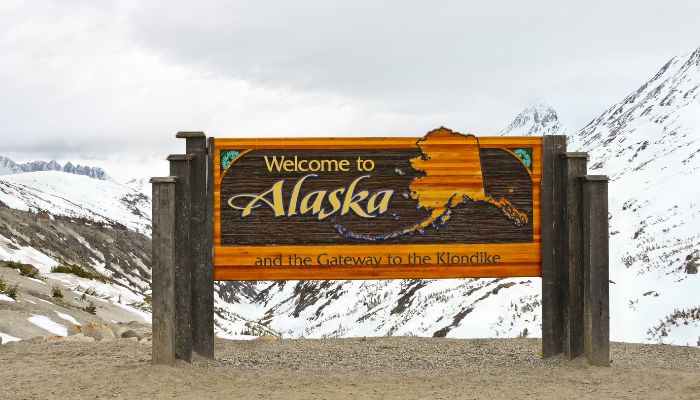Why Alaska is the Most Dangerous State: Understanding the Factors Behind High Crime Rates and Accidents
Alaska is known for its stunning natural beauty, but it is also notorious for being the most dangerous state in America. With its remote location and harsh climate, Alaska has a unique set of challenges when it comes to public safety. Crime rates in Alaska have consistently been higher than the national average, and the state has the highest rate of violent crime in the country.

According to FBI data, Alaska has the highest rate of violent crime per capita in the United States. This includes murder, rape, aggravated assault, and robbery. The state’s high crime rate is often attributed to its remote location, harsh climate, and lack of law enforcement resources. The vastness of the state and its sparse population make it difficult to police effectively, and many communities are isolated and only accessible by plane or boat.
Despite its reputation as a dangerous state, Alaska is also home to many tight-knit communities where residents look out for each other. The state has a unique culture and way of life that is deeply connected to the land and its resources. While there are certainly challenges when it comes to public safety, many Alaskans take pride in their resilience and ability to overcome adversity.
Geographical and Societal Factors Contributing to Danger

Alaska is known to be the most dangerous state in the United States, with a high rate of violent crimes and accidents. The state’s harsh weather and remote terrain, isolation of rural and native villages, socioeconomic challenges, limited law enforcement presence, high rates of substance abuse, prevalence of domestic and sexual violence, cultural factors and historical context, infrastructure and transportation challenges, economic dependency on high-risk industries, and climate change impact are some of the factors contributing to Alaska’s danger.
Harsh Weather and Remote Terrain
Alaska’s weather is known to be unpredictable and extreme, with temperatures that can drop to -50°F in some areas. The state’s remote terrain, which includes glaciers, mountains, and tundra, makes it difficult for rescue teams to reach people in case of emergencies. Wildfires, earthquakes, and avalanches are also common in Alaska, making it challenging to navigate and survive in the state’s wilderness.
Isolation of Rural and Native Villages
Alaska’s rural and native villages are often located in remote areas, making it difficult for residents to access essential services like healthcare and law enforcement. These communities face unique challenges due to their isolation, and residents must be self-sufficient and prepared to handle emergencies on their own.
Socioeconomic Challenges
Alaska has high poverty rates, limited access to education, and high unemployment rates, which contribute to the state’s high crime rate. Many communities, especially indigenous communities, face systemic issues that contribute to higher incidences of crime.
Limited Law Enforcement Presence
Alaska has a limited law enforcement presence, with only a few police officers and state troopers covering vast areas. This limited presence makes it difficult to respond to emergencies and investigate crimes, leading to a high rate of unsolved cases.
High Rates of Substance Abuse
Alaska has high rates of substance abuse, including alcoholism and drug addiction. The state has the highest per capita alcohol consumption in the country, contributing to a high rate of alcohol-related accidents and violence.
Prevalence of Domestic and Sexual Violence
Alaska has one of the highest rates of domestic and sexual violence in the country, with women, children, and Alaska Native communities being disproportionately affected. The prevalence of domestic and sexual violence contributes to the state’s overall danger.
Cultural Factors and Historical Context
Alaska’s culture and history contribute to the state’s danger. The state’s remote areas and harsh weather have shaped the way of life for many Alaskans, and traditional practices like hunting and fishing can be dangerous. Additionally, the state’s history of colonization and forced assimilation has led to intergenerational trauma and contributed to the prevalence of domestic and sexual violence.
Infrastructure and Transportation Challenges
Alaska’s infrastructure and transportation challenges, including limited roads and the need for plane or boat travel in many areas, contribute to the state’s danger. Transportation accidents are common in Alaska, and the limited infrastructure makes it difficult to respond to emergencies.
Economic Dependency on High-Risk Industries
Alaska’s economy is heavily dependent on high-risk industries like fishing, logging, and oil drilling. These industries are dangerous and can lead to accidents and injuries, contributing to the state’s overall danger.
Climate Change Impact
Alaska is one of the states most affected by climate change, with rising temperatures, melting permafrost, and increased risk of wildfires. These climate change impacts contribute to the state’s overall danger.
In summary, Alaska’s geographical and societal factors contribute to the state’s danger, making it the most dangerous state in the United States.
Crime Statistics and Law Enforcement Response

Violent Crime Rates and Comparison
Alaska has one of the highest violent crime rates in the United States. According to the FBI’s 2022 crime report, Alaska’s violent crime rate was 603.2 per 100,000 people, compared to the national average of 386.9. Alaska’s violent crime rate is the highest of all the states, followed by New Mexico. The state’s murder rate is also high, with a 67% increase in 2022, according to the latest Alaska crime report.
Specifics of Criminal Activities
The statistics show that rape and aggravated assault are the primary drivers of Alaska’s high violent crime rate. The backlog of untested sexual assault examination kits in Alaska has been cleared and is now in the system, according to the Department of Public Safety’s annual crime report. Property crime rates have decreased significantly, and the rate of sexual assault is down significantly in Western Alaska, with a decrease of close to 9% in felony sex crimes.
Law Enforcement and Community Initiatives
The Alaska State Troopers and local police departments are responsible for enforcing the law and responding to criminal activities. The state troopers’ main focus is on rural Alaska, where they are responsible for patrolling vast areas with limited resources. The police presence in urban areas is relatively high, but there is still a need for more police officers to address the high crime rate.
The Standing Together Against Rape (STAR) program is an initiative aimed at supporting sexual assault victims and their families. The program provides counseling, advocacy, and education to help victims and their families cope with the trauma of sexual assault. The program also offers training for law enforcement officers and community members to raise awareness of sexual assault and how to prevent it.
Efforts Towards Prevention and Education
Education and awareness are essential to preventing crime. The Alaska State Troopers and local police departments work with schools and community organizations to educate people about crime prevention and how to stay safe. Activists and researchers also conduct surveys and studies to better understand the root causes of crime and how to prevent it.
Support Systems and Hotlines
Victims of sexual assault and domestic violence can call the National Sexual Assault Hotline and the National Domestic Violence Hotline for support and assistance. The Alaska State Troopers and local police departments also have victim advocates who can provide support and assistance to victims of crime.
Overall, the high crime rate in Alaska is a complex issue that requires a multi-faceted approach. Law enforcement, community organizations, and individuals must work together to prevent crime and support victims of crime.
Frequently Asked Questions

What factors contribute to Alaska’s high crime rate?
Alaska’s high crime rate can be attributed to various factors such as poverty, lack of education, limited access to healthcare, and alcohol and drug abuse. Many communities, particularly indigenous communities, face systemic issues that contribute to higher incidences of crime. Additionally, the state’s vast and remote geography, coupled with its harsh weather conditions, makes it difficult for law enforcement to respond promptly to emergencies.
How does Alaska’s crime rate compare to other US states?
Alaska has consistently been ranked as the most dangerous state in the US in terms of violent crime rates. According to the FBI’s Uniform Crime Reporting Program, Alaska’s violent crime rate was 804.2 per 100,000 inhabitants in 2019, compared to the national average of 367.9 per 100,000 inhabitants.
What is the safest city in Alaska?
While no city in Alaska can be considered completely safe, some cities have lower crime rates than others. According to recent data, the city of Sitka has the lowest crime rate in Alaska, with a violent crime rate of 121.4 per 100,000 inhabitants. However, it is important to note that even the safest cities in Alaska have higher crime rates than the national average.
What are the reasons behind the high number of murders in Alaska?
The high number of murders in Alaska can be attributed to several factors, including a high rate of alcohol and drug abuse, domestic violence, and a lack of mental health resources. Additionally, the state’s remote geography and harsh weather conditions make it difficult for law enforcement to respond quickly to emergencies.
How does the small population of Alaska affect its crime statistics?
Alaska’s small population size can make its crime statistics appear more alarming than they actually are. With a population of just over 700,000, a small number of crimes can significantly impact the state’s crime rate. However, it is important to note that Alaska consistently ranks as the most dangerous state in the US in terms of violent crime rates, even when adjusted for population size.
What measures are being taken to improve safety in Alaska?
Various measures are being taken to improve safety in Alaska, including increasing law enforcement presence in rural areas, improving access to mental health resources, and addressing the root causes of crime such as poverty and substance abuse. Additionally, community-based initiatives and partnerships between law enforcement and community organizations have been established to promote safety and prevent crime.






